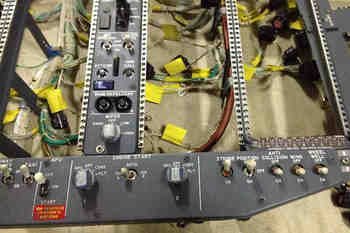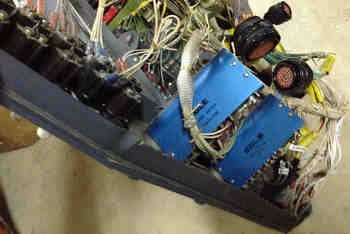Genuine B737 Forward & Aft Overhead Panels Purchased
/
For some time I’ve been debating whether to use a reproduction or OEM forward and aft overhead panel. I have been favouring an OEM panel as this is in line with using genuine parts in the simulator, however, the overhead is a complicated piece of kit and ensuring complete functionality would be a challenge.
RIGHT: Forward Overhead Panel. The centre panels will be replaced to conform to a 737 Next Generation. Panel was removed from a United Airlines 737-300 aircraft.
Certainly, using an overhead panel made by Flight Deck Solutions (FDS) is an easier option, however, despite their reproduction panels being high quality, there are discernible differences between reproduction and OEM panels.
OEM 737 Overhead Panel Purchased
My decision was made for me when I was told a forward and aft overhead had become available from a recent 737 pull down. Rather than remain indecisive, I thought I’d jump in “boots and all” and purchase it. The two overhead panels have come from B737-300 and include the frames, DZUS rails, center panels, Cole engine starter switches, landing gear toggles and various other knobs and toggles.
I’m impressed at the condition of the panels; usually when panels are removed from an aircraft in a tear down yard there is little care given, and the frames become scratched, dented, or damaged in some way. The frames I have purchased appear to be in relatively good condition.

Cole Switches
I was fortunate that the two engine starter switches (Cole switches) were included. These switches are made to exacting requirements and use a solenoid mechanism.
LEFT: Difficult to find operating Cole switches are used on all Boeing airframes from the 727 through to the Next Generation.
Purchasing Cole switches individually is quite expensive, so I'm pleased they were not striped from the overhead.
Panels and Backlighting
When I began to construct the simulator in mid 2011, I was adamant that backlighting should match that of the MIP, throttle quadrant and center pedestal. I believe it was around 2006 that Boeing began to replace bulbs in favour of LEDS. Certainly, the latest made Boeing uses LEDS. Therefore, my opinion has changed and I am happy to mix bulbs and LEDS (within reason)
The use of bulbs in the overhead uses a lot of power and generates considerable heat; using LEDS minimises power consumption and produces less heat. If the LEDS are installed correctly, their resultant light is very similar to that of bulbs, and the brightness observed in the real aircraft.
Ultimately the back lighting will be dependent on whether I decide to use older style genuine Boeing panels or reproduction panels.
Realism & Authenticity - How Far Do You Go
Some flight deck builders go to extremes to ensure their flight decks replicate exactly what is seen in the real aircraf,t and while this is admirable, this is not the route I am 'religiously' going to travel. There has to be compromise between replicating something exactly and having a functional flight simulator.
The end product will be a combination of genuine (OEM) and reproduction parts - mostly OEM.
Furthermore, serious thought must also be given to how the overhead is going to be installed to the simulator; whether it be to a shell, such as produced by FDS or to a custom-made roll cage assembly.
I'll keep the Blog updated as parts are found and the overhead is developed.
Unfortunately I do not have any high quality pictures. These images were supplied by the vendor. Currently the overhead is still located in the US. In time better quality images will be uploaded.











































